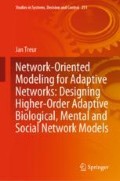Abstract
The concept of multilevel network reification introduced in the previous chapters enables representation within a network not only of first-order adaptation principles, but also of second-order adaptation principles expressing change of characteristics of first-order adaptation principles. In the current chapter, this approach is illustrated for an adaptive Social Network. This involves a first-order adaptation principle for bonding by homophily represented at the first reification level, and a second-order adaptation principle describing change of characteristics of this first-order adaptation principle, and represented at the second reification level. The second-order adaptation addresses adaptive change of two of the characteristics of the first-order adaptation, specifically similarity tipping point and connection adaptation speed factor.
Access this chapter
Tax calculation will be finalised at checkout
Purchases are for personal use only
References
Blankendaal, R., Parinussa, S., Treur, J.: A temporal-causal modelling approach to integrated contagion and network change in social networks. In: Proceeding of the 22nd European Conference on Artificial Intelligence, ECAI’16. IOS Press, Frontiers in Artificial Intelligence and Applications, vol. 285, pp. 1388–1396 (2016)
Boomgaard, G., Lavitt, F., Treur, J.: Computational analysis of social contagion and homophily based on an adaptive social network model. In: Proceedings of the 10th International Conference on Social Informatics, SocInfo’18. Lecture Notes in Computer Science, vol. 11185, pp. 86–101, Springer Publishers (2018)
Byrne, D.: The attraction hypothesis: do similar attitudes affect anything? J. Pers. Soc. Psychol. 51(6), 1167–1170 (1986)
Carley, K.M.: Inhibiting adaptation. In: Proceedings of the 2002 Command and Control Research and Technology Symposium, pp. 1–10. Naval Postgraduate School, Monterey, CA (2002)
Carley, K.M.: Destabilization of covert networks. Comput. Math. Organ. Theor. 12, 51–66 (2006)
Carley, K.M., Lee, J.-S., Krackhardt, D.: Destabilizing networks. Connections 24(3), 31–34 (2001)
Holme, P., Newman, M.E.J.: Nonequilibrium phase transition in the coevolution of networks and opinions. Phys. Rev. E 74(5), 056108 (2006)
Kozyreva, O., Pechina, A. Treur, J.: Network-oriented modeling of multi-criteria homophily and opinion dynamics in social media. In: Koltsova, O., Ignatov, D.I., Staab, S. (eds.) Social Informatics: Proceedings of the 10th International Conference on Social Informatics, SocInfo’18, vol. 1. Lecture Notes in AI, vol. 11185, pp. 322–335 Springer (2018)
Levy, D.A., Nail, P.R.: Contagion: a theoretical and empirical review and reconceptualization. Genet. Soc. Gen. Psychol. Monogr. 119(2), 233–284 (1993)
McPherson, M., Smith-Lovin, L., Cook, J.M.: Birds of a feather: homophily in social networks. Annu. Rev. Soc. 27, 415–444 (2001)
Pearson, M., Steglich, C., Snijders, T.: Homophily and assimilation among sport-active adolescent substance users. Connections 27(1), 47–63 (2006)
Sharpanskykh, A., Treur, J.: Modelling and analysis of social contagion in dynamic networks. Neurocomputing 146, 140–150 (2014)
Treur, J.: Network-oriented modeling: addressing complexity of cognitive, affective and social interactions. Springer Publishers (2016)
van Beukel, S., Goos, S., Treur, J.: An adaptive temporal-causal network model for social networks based on the homophily and more-becomes-more principle. Neurocomputing 338, 361–371 (2019)
Vazquez, F.: Opinion dynamics on coevolving networks. In: Mukherjee, A., Choudhury, M., Peruani, F., Ganguly, N., Mitra, B. (eds.) Dynamics On and Of Complex Networks, Volume 2, Modeling and Simulation in Science, Engineering and Technology, pp. 89–107. Springer, New York (2013)
Vazquez, F., Gonzalez-Avella, J.C., Eguíluz, V.M., San Miguel, M.: Time-scale competition leading to fragmentation and recombination transitions in the coevolution of network and states. Phys. Rev. E 76, 046120 (2007)
Author information
Authors and Affiliations
Corresponding author
Rights and permissions
Copyright information
© 2020 Springer Nature Switzerland AG
About this chapter
Cite this chapter
Treur, J. (2020). Using Multilevel Network Reification to Model Second-Order Adaptive Bonding by Homophily. In: Network-Oriented Modeling for Adaptive Networks: Designing Higher-Order Adaptive Biological, Mental and Social Network Models. Studies in Systems, Decision and Control, vol 251. Springer, Cham. https://doi.org/10.1007/978-3-030-31445-3_6
Download citation
DOI: https://doi.org/10.1007/978-3-030-31445-3_6
Published:
Publisher Name: Springer, Cham
Print ISBN: 978-3-030-31444-6
Online ISBN: 978-3-030-31445-3
eBook Packages: EngineeringEngineering (R0)

